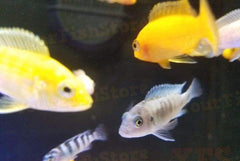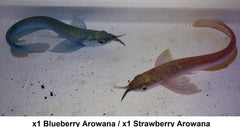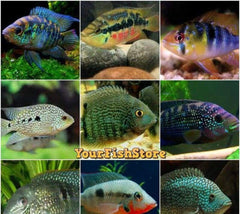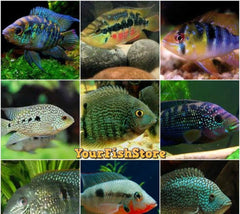200+ Schooling Fish Package - (X50) Barbs (X150)Tetra - Freshwater Live *Bulksave
Ebay
$ 323.54

This package includes:
x50 RUMMYNOSE TETRA
x50 BLACK SKIRT TETRA
x50 CHERRY BARB
x50 CARDINAL TETRA
*This package contains 200 Fish
Approx 1/2" - 1 1/2" Each
Many species of animals live in groups to protect themselves from their enemies – especially when the animals are small and vulnerable on their own. This is definitely the case with fish in their native environment. Think about it – a predator would have a much easier time chasing down and eating a single fish swimming by itself than it would singling out a single fish from a large group. Territorial defense is also easier in numbers – a potential rival might balk at the idea of facing a large group of fish as opposed to a single fish. Some scientists have also posed the idea that swimming in large groups reduces energy expenditure for fish and that it makes finding food easier (with more pairs of eyes on the lookout). In terms of breeding, a large school spawning together stands a greater chance of some of their eggs hatching simply due to the large number of eggs laid in a single area.
Schooling is a very common behavior among fish and it is estimated that as many as 80% of fish live in a school at some point. Small fish and newly hatched fry tend to spend more time in schools than larger fish who can fend for themselves, though some large species do tend to school. For fish, schooling isn’t quite as simple as just gathering with a group and swimming in the same area. Schooling fish swim extremely close together – so close that you might wonder how they do not get in each other’s way. Scientific studies have shown that the leader of the school influences the movements of the rest of the fish – the other fish take cues from the fish around them, responding to various stimuli around them. It also makes sense in regard to the anatomy of fish – they have eyes on the sides of their heads so they can easily see what is on either side of them.
FACTORS FOR SWIMMING IN A SCHOOL
Fish feels safer from predators when in group
Higher chance of finding food this way
Easier to find a mate while in schools
Higher hydrodynamic efficiency while swimming long distance
One thing that makes this type of fish particularly interesting for aquarists and others is the beauty of schooling species.
The way they move close to each other while keeping in perfect rhythm is incredible.
It is like they are being operated from one mind at the same time—all in your home aquarium!
Whether you keep them alone (Really not advisable for a schooling fish) or with other fish species, they will surely entertain you and boost the activity in your tank.Feeding Your Fish:
Be careful not to overfeed your fish! Any food the fish does not eat will pollute the tank. Experts suggest feeding your fish relatively small amounts of food once or twice a day. If they eat all of the food within a few minutes, it is okay to add a bit more, as long as they eat all (or at least most) of it within a short period of time. Over time, you will get a better idea for how much food the fish can eat, and you can adjust the feeding amounts to fit the needs of your fish. The experts at your local pet shop can demonstrate good feeding practices as well as suggest food options for your fish. In terms of nutritional needs, please remember that fish are the same as their non-fluorescent counterparts. Flaked food and live food such as brine shrimp are good options.
Water Temperature:
Every kind of fish has its own temperature preferences. In general, fish can live in a fairly wide temperature range, anywhere from 64-86°F (18–30°C), but prefer temperatures of 72-80°F (22-27°C). Depending upon the temperature of the room in which your aquarium is maintained, an aquarium heater may be helpful to maintain this temperature range. The most important thing to remember is to avoid quick temperature changes, since these can be fatal for the fish.
QUESTIONS & ANSWERS
Have a Question?
Be the first to ask a question about this.














